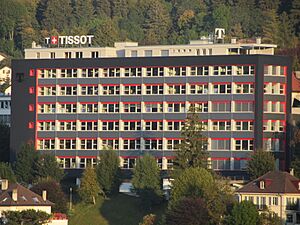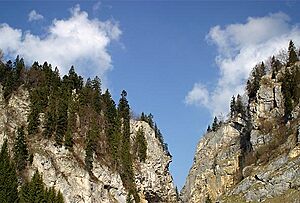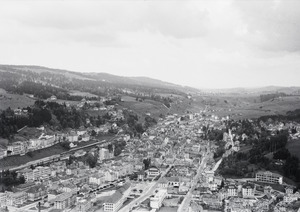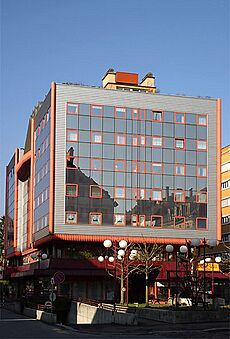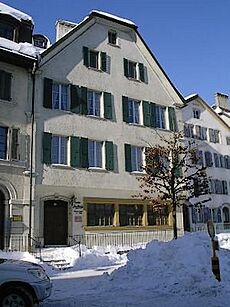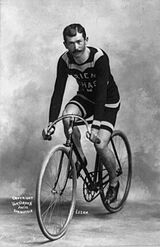Le Locle facts for kids
Quick facts for kids
Le Locle
|
||
|---|---|---|
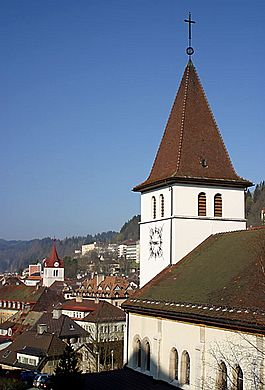 |
||
|
||
| Lua error in Module:Location_map at line 416: Malformed coordinates value. | ||
| Country | Switzerland | |
| Canton | Neuchâtel | |
| Area | ||
| • Total | 34.69 km2 (13.39 sq mi) | |
| Elevation | 945 m (3,100 ft) | |
| Population
(Dec 2020 )
|
||
| • Total | 9,864 | |
| • Density | 284.35/km2 (736.46/sq mi) | |
| Postal code |
2400
|
|
| Surrounded by | La Chaux-de-Fonds, La Chaux-du-Milieu, La Sagne, Le Cerneux-Péquignot, Les Brenets, Les Planchettes, Les Ponts-de-Martel, Villers-le-Lac (FR-25) | |
| UNESCO World Heritage Site | |
|---|---|
| Part of | La Chaux-de-Fonds / Le Locle, Watchmaking Town Planning |
| Criteria | Cultural: (iv) |
| Inscription | 2009 (33rd Session) |
| Area | 70.2 ha (173 acres) |
| Buffer zone | 1,620.2 ha (4,004 acres) |
Le Locle is a town in Switzerland. It is located in the Jura Mountains, close to the city of La Chaux-de-Fonds. Le Locle is known as a major center for Swiss watchmaking. Some people even say it's where the watch industry began, way back in the 1600s.
Many famous watch brands like Tissot, Ulysse Nardin, and Zenith have their roots here. You can learn all about this history at the Musée d'Horlogerie du Locle, a special museum about clocks and watches. It's in a beautiful old manor house on a hill. There are also old underground mills (for grinding grain, making oil, and sawing wood) that you can visit in a cave nearby.
The town's name, Le Locle, comes from an old word meaning "lake" or "water hole."
Contents
UNESCO World Heritage Site: Watchmaking Town Planning
Le Locle and its neighbor, La Chaux-de-Fonds, are very important because of their watchmaking history. This industry helped them grow and survive. Watchmaking came to Le Locle in the 1600s thanks to Daniel Jeanrichard. He was a self-taught watchmaker who encouraged local farmers to make watch parts during the long winter months. Later, in the 1900s, the town also became known for tiny, precise mechanical parts.
Both Le Locle and La Chaux-de-Fonds have been recognized by UNESCO as a World Heritage Site. This means they are considered very special and important to the whole world.
The area around Le Locle is high up (about 1,000 m (3,300 ft)) and the ground is made of porous limestone. This means it's not great for farming. Because of this, the towns were planned and built to suit the watchmaking industry. After big fires in the early 1800s, the towns were rebuilt with a special layout.
Their town planning shows how watchmaking workshops and homes were mixed together in parallel streets. This design helped the watchmaking culture, which started in the 1600s and is still active today. These towns are great examples of places built around one main industry. Their design helped them change from small home-based workshops to larger factories in the late 1800s and 1900s.
Even Karl Marx, a famous thinker, wrote about La Chaux-de-Fonds in his book Das Kapital. He called it a "huge factory-town" and studied how watchmaking work was divided up there.
Le Locle and La Chaux-de-Fonds were the tenth Swiss site to become a World Heritage site. Other famous Swiss sites include the Old City of Bern and the Rhaetian Railway.
History of Le Locle
Le Locle was first mentioned in records in 1332.
Early Settlements
The oldest signs of people living here are from around 6000–5000 BC. These were found in a shelter at Col des Roches. Tools, old pottery, and bones from mammoths and deer were discovered there. This site was the first of its kind studied in Switzerland.
However, we don't know much about the Le Locle area between 4000 BC and the Middle Ages.
The Middle Ages in Le Locle
In 1150, the valley where Le Locle now stands was given to a monastery. Later, in 1360, a local lord received Le Locle as a special gift from the Count of Neuchâtel. The thick forests around Le Locle were cleared by early settlers. These settlers were given special rights as "free peasants" in 1372. This meant they could own the land they cleared, as long as they farmed it and paid taxes. The lords gave them these freedoms to encourage more people to settle in the mountains.
Around the 14th century, Le Locle and a nearby village called La Sagne shared a church area. The Church of Mary Magdalene in Le Locle was built in 1351.
To protect itself from conflicts, Le Locle joined an alliance with the city of Bern in 1476. In 1502, 37 people in Le Locle bought the title of "Citizen of Valangin." This gave them the right to lead the community and choose their own mayor.
From Early Modern Times to Today
The tower of the Church of Mary Magdalene, which is a landmark of the city, was built in the early 1500s. A few years later, in 1536, Le Locle became Protestant. The old church was rebuilt in the mid-1700s.
In 1592, Le Locle became part of the County of Neuchâtel. Its alliance with Bern remained strong. During big wars like the Thirty Years' War, soldiers from Bern came to help protect the town. Le Locle also sent its own soldiers to help Bern in other battles.
Being close to the French border meant Le Locle often had strong ties with France. This was especially true before the French Revolution. Many people from Le Locle supported the revolution. This led to some conflicts, and many residents had to leave for a short time in 1793. They went to Besançon in France, where they found work in a watch factory. When they returned, they brought back new watchmaking skills and a spirit of change.
In 1707, the area of Neuchâtel became part of the Kingdom of Prussia. Later, Napoléon Bonaparte took control for a short time. But in 1814, it went back to Prussia. A year later, Neuchâtel joined the Swiss Confederation as a full member. This made Neuchâtel unique because it was the only monarchy (ruled by a king) to join the otherwise republican (ruled by the people) Swiss cantons.
This changed in 1848, when a peaceful revolution started in Le Locle. The king's forces quickly gave up, and on February 28, 1848, the flag of the Swiss Republic was raised over the city. Le Locle became a prefecture (a local government area) until 1935. In 1856, royalist forces briefly took over the town during an attempt to reverse the revolution, but it failed.
Le Locle suffered from big fires in 1683, 1765, and 1833. It was rebuilt in the mid-1800s, becoming the watch industry center we see today.
Modern Era and Industry
The Bied river in the valley used to flood often. So, in the early 1800s, a channel was dug to control it. Until 1898, the river's power was used for several underground mills.
The town also focused on education. A high school opened in 1855, a teacher training college in 1866, and a trade school in 1897. The watchmaking school, started in 1868, became the basis for a technical school in 1901–02. This school is now part of a larger engineering school.
Le Locle worked hard to get railway lines. The first line to La Chaux-de-Fonds opened in 1857, followed by lines to Besançon (France) in 1884 and Les Brenets in 1890.
Le Locle's success comes mostly from its watch industry. This includes making very precise watches and the machines that make them. Daniel Jeanrichard was one of the first people to start this industry here. In 1750, there were only about 77 watchmakers in the Le Locle area. By 1800, this number grew to over 800! Watchmaking soon became more important than farming and lacemaking.
Many famous watchmakers and inventors came from Le Locle, like Abraham-Louis Perrelet. In the 1800s, the town was known for its pocket watches and marine chronometers (very accurate clocks for ships). At first, watches were made by hand in small shops. But by the late 1800s, the first factories were built. This led to more machine-made parts and tools for watches. During the two World Wars, some factories, like Zenith, even made weapons.
Watchmaking also needed artists and engravers. Samuel Girardet, a bookseller, started decorating clock cases and his family became famous artists. The Huguenin family was known for painting clock housings and medals. A chocolate factory, Klaus, also operated here from 1856 to 1992.
Like other watchmaking towns in the Jura, Le Locle's politics were influenced by new ideas like radicalism and socialism. In 1866, a professor suggested creating a workers' organization. By the late 1800s, many German-speaking workers came to Le Locle. Socialists formed a political party in 1897 and gained power.
On January 1, 2021, the nearby village of Les Brenets joined Le Locle to become one municipality.
Geography and Landscape
Le Locle is located on the Swiss side of the cluse (a narrow valley) called Col des Roches. This valley forms part of the border between France and Switzerland.
The municipality of Le Locle covers an area of about 23.14 km2 (8.93 sq mi). More than half of this land (53.6%) is used for farming, while almost 30% is covered by forests. About 16% of the land has buildings or roads.
The town center of Le Locle is located at an elevation of about 946 m (3,104 ft).
Town Symbols
The coat of arms of Le Locle has a special design. It shows red and gold diamond shapes, with a wavy blue line across the middle. At the bottom, there are three green pine trees on green hills.
People of Le Locle
Le Locle has a population of about 10,422 people (as of 2013). About 26% of the people living here are from other countries.
Most people in Le Locle (about 88%) speak French as their main language. Italian is the second most common language, and German is third.
In 2008, about 49.2% of the population was male and 50.8% was female. About 37% of the people living in Le Locle in 2000 were also born there.
The population of Le Locle has changed over time:

Important Buildings and Sites
Several places in Le Locle are listed as important national heritage sites. These include:
- The old Post Office building
- Monts Castle and the Museum of Horology (watchmaking)
- The City Hall
- The Moulins souterrains du Col-des-Roches (underground cave mills)
- The Villa Favre-Jacot
- The Zenith SA building (a watch factory)
The entire town of Le Locle and the village of Les Brenets are also part of the Inventory of Swiss Heritage Sites.
Economy and Jobs
In 2010, Le Locle had an unemployment rate of 7.6%. Most jobs in Le Locle are in the secondary sector, which includes manufacturing. This means many people work in factories, especially those related to watchmaking.
In 2008, there were over 7,000 full-time jobs in Le Locle. A large number of these (over 4,900) were in manufacturing, particularly in making watches. Other jobs were in agriculture, construction, sales, transportation, hotels, and healthcare.
Many people (over 4,200) travel into Le Locle for work, while fewer (about 1,800) travel out. This means Le Locle is a place where many people come to find jobs. Most people use a private car to get to work, but some use public transportation.
Religion
Based on a 2000 survey, about 34% of the population in Le Locle were Roman Catholic. About 29.8% belonged to the Swiss Reformed Church (a Protestant church). There were also smaller numbers of people who were Orthodox Christians, other Christians, or Muslims. About 23% of the population did not belong to any church or were agnostic or atheist.
Education
In Le Locle, about 32.7% of the population has finished high school (upper secondary education). About 9.8% have gone on to higher education, like university.
In the canton of Neuchâtel, where Le Locle is located, most towns offer two years of kindergarten, followed by five years of primary school. After that, students attend secondary school for four years, often traveling to larger schools outside their home town.
In the 2010–11 school year, Le Locle had 10 kindergarten classes with 185 students and 31 primary classes with 564 students.
Le Locle also has a public library called the Bibliothèque de la Ville Le Locle.
Transportation
Le Locle has several railway stations. The main one is Le Locle, which has regular train services to La Chaux-de-Fonds and Neuchâtel.
There's also a special inclined elevator called Le Remontoir. It connects the Le Locle railway station to the town center.
Sister Cities
Le Locle has "sister city" relationships with two other towns:
Notable People from Le Locle
Many interesting people were born in Le Locle, including:
- Charles Girardet (1813–1871), a painter and illustrator.
- Lucien Lesna (1863–1932), a cyclist who won the famous Paris–Roubaix races in 1901 and 1902.
- Oscar Tschirky (1866–1950), a famous hotel manager at the Waldorf Astoria in New York.
- Pierre Favre (born 1937), a jazz drummer.
- Bernard Challandes (born 1951), a soccer coach.
- Sébastien Jeanneret (born 1973), a former Swiss football player.
See also
 In Spanish: Le Locle para niños
In Spanish: Le Locle para niños




